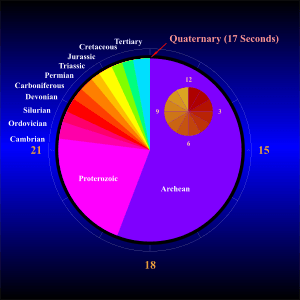History of the geologic time scale facts for kids
Orange labels: known ice ages.
Also see: Human timeline and Nature timeline
Have you ever wondered how scientists know the age of the Earth or how long ago dinosaurs lived? They use something called the geologic time scale. This is like a giant calendar that maps out Earth's incredibly long history. It helps us understand when different rocks formed, when mountains rose, and when life changed over millions of years.
The idea for this time scale started with a smart scientist named Nicolaus Steno in the late 1600s. He figured out that rock layers, called strata, are usually stacked on top of each other like pancakes. The layers at the bottom are generally older than the ones on top. This simple but important idea is called the principle of superposition.
Contents
Early Ideas About Earth's Timeline
In the 1700s, scientists started trying to make a time scale that could be used all over the Earth. One of the first big attempts was led by Abraham Gottlob Werner. He divided the rocks in Earth's crust into four main types: Primary, Secondary, Tertiary, and Quaternary.
- Primary rocks were thought to be the oldest.
- Secondary rocks came next.
- Tertiary and Quaternary were the most recent.
These names were used to describe both the rocks themselves and the time periods when they formed. For example, people talked about the "Tertiary period" and "Tertiary rocks." Some of these names, like Tertiary and Quaternary, are still used today, though sometimes with different meanings or as parts of larger periods.
The Neptunists vs. Plutonists
Werner had an interesting idea called the Neptunist theory. He believed that all rocks had formed by settling out of a single, huge flood that once covered the Earth.
But then, James Hutton came along in the late 1700s with a different idea. He is often called the "founder of modern geology." Hutton suggested that the inside of the Earth was very hot. This heat, he thought, was like an engine that created new rocks. He believed that land was slowly worn away by wind and water. This material then settled in the sea, forming layers. Over time, the Earth's heat would turn these layers into hard rock and push them up to form new land. This idea was called the Plutonist theory, because it involved heat from deep within the Earth (like Pluto, the Roman god of the underworld).
Using Fossils to Date Rocks
In the early 1800s, scientists like William Smith and Georges Cuvier made a huge discovery. They found that they could identify rock layers by the fossils found inside them.
- If two rock layers, even far apart, contained the same types of fossils, it was very likely they formed at the same time.
This discovery helped geologists divide Earth's history much more accurately. Between 1820 and 1850, detailed studies of rocks and fossils in Europe led to the sequence of geological periods we still use today.
Cuvier also thought that many big changes on Earth, like the extinction of many animal species, were caused by sudden, huge events. This idea is called catastrophism. He later believed there wasn't just one big event, but several, which led to different groups of animals living at different times.
Naming the Geological Periods
Many of the names for geological periods come from places where the rocks were first studied.
- The "Cambrian" period is named after Cambria, the old Roman name for Wales.
- The "Ordovician" and "Silurian" periods are named after ancient Welsh tribes.
- The "Devonian" period is named after Devon, a county in England.
- The "Carboniferous" period got its name because it's when most of the world's coal (carbon) formed.
- The "Permian" period was named after Perm, a region in Russia, by a Scottish geologist named Roderick Murchison.
British geologists also helped group these periods into larger units called eras. They also divided the Tertiary and Quaternary periods into smaller parts called epochs.
Modern Dating Methods
For a long time, geologists and paleontologists could only figure out the *relative* age of rocks. This meant they knew which rocks were older or younger than others, based on their position and fossils. They tried to estimate how long things took by studying processes like weathering, erosion, and how long it took for sediment to turn into hard rock.
Then, in 1896, something amazing was discovered: radioactivity. In the first half of the 20th century, scientists learned how to use radioactivity to find the *absolute* age of rocks. This method is called radiometric dating. It finally allowed them to figure out the actual age of the Earth in years!
Today, the International Commission on Stratigraphy works to define exactly when each geological period starts and ends. They also identify the best places in the world to see the boundaries between these periods. These special spots are called Global Boundary Stratotype Sections and Points (GSSP).
Images for kids



